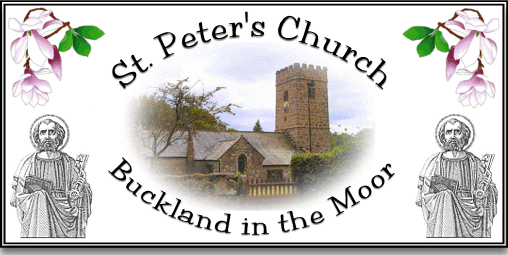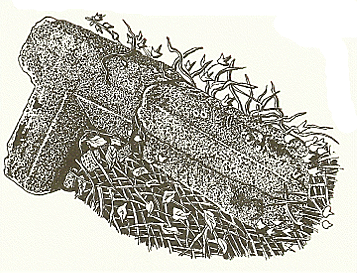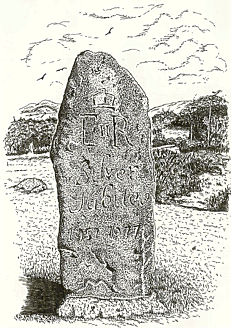
Buckland in the Moor has for many years been on the route of the visitor’s ‘grand tour’ of Dartmoor. Many people coming to see the famous ‘chocolate box’ thatched cottages and dream about living in such an idyllic spot. The ironic thing is that if ever anyone was fortunate enough to live in such a house they would have to put up with hundreds of other people gawking at their home wishing they could live there – not what you could call privacy. But for me the true ‘gem’ of Buckland in the Moor is the church – see ill 1 here, which stands about half a mile up the road. This small moorland church stands majestically on top of the hill and looks out over splendid wooded views of the Webburn valley – see ill. 2 here. Here Saint Peter stares westwards into the eyes of Saint John, the two holy men seem to stand guard over the valley. Why? because the church at Buckland is dedicated to Saint Peter and to the west is the church at Leusdon which is dedicated to Saint John. But the church at Leusdon is nought but a ‘cheel’ (child) when compared to Buckland church, the former was built in 1863 where as the latter can boast a history dating back to the 12th century.
The ancient manor of Buckland appears in the Domesday Book as Bochelande which means ‘Book Land’ or land held by charter. In 1086 Buckland was recorded as:

Digital Domesday – 2004
“Nicholas himself holds BUCKLAND IN THE MOOR, Æthelsige held it T.R.E*., and it paid geld for 3 virgates of land. There is land for 4 ploughs. There are 3½ ploughs, and 3 slaves and 8 villans and 2 bordars, and 4 acres of meadow and 4 furlongs of Pasture. woodland half a league long on 1 furlong broad. Formerly, as now, worth 10s”.* Tempore Regis Edwardi – In the time of King Edward or before the conquest of 1066.This possibly refers to the period when the lands of the manor were held by the Bishop of Crediton before the 11th century. By the 13th century the lands were once again held under charter, this time by Torre Abbey. By the 14th century Buckland had become encompassed in the Manor of Stoke in Teignhead and then later became included in the estates of Wolborrow manor. In 1578 the manor had become independent and was sold to Raphe Woodleigh who in 1614 sold up to the Bastard family. The Bastard’s held the manor for the next 300 years, Brown, 1996, p.3. In Risdon’s survey of Devon, 1811, pp. 151-2, 378, he notes the following:
“Buckland, commonly called Buckland in the Moor, of its scite, whence Roger de Buckland, a man of great worth and wealth took his name, of whom William de Buckland was the sheriff of this shire and Cornwall, in the reign of King Richard the first, five years together. After which family sir John Erchdecon succeeded to the land“.
“BUCKLAND IN THE MOOR is the property of John Pollexfen Bastard, Esq, who has here one of the most delightful seats in the county. He has planted here seven hundred acres”.
So, clearly the manor can boast a place back in the annals of time and so can the church. It is thought that there was a place of worship on the site since the 12th century of which proud boast the south wall of the nave can testify. Orme, 1996, p.140, lists that the first mention of the dedication to St. Peter was in 1547 but then after the reformation it was ‘forgotten’ until some time in the late 1800’s when it was re-instated. The first documentary evidence of the church is in 1420 when it appears in Bishop Lacey’s register. Since the early 1930’s the church has earned its place on the ‘grand tour’ of Dartmoor by dint of the grand clock, or rather the two faces of the timepiece.
I like many have often visited St. Peter’s, seen the clock, admired the views, and whizzed around the church. But this time I was fortunate enough to meet Mr. Layley who pointed out many facets of this Dartmoor ‘jewel’ that possibly become overshadowed by the clock etc. As you enter the churchyard don’t go charging off to see the clock but have a look at the small lichen decked hawthorn growing by the gate – see ill. 3 here, it is testament to a brave struggle against the vagaries of Dartmoor. This is one of three other pink hawthorns that along with a series of various flowering cherry trees were planted in 1953 to mark the Queens coronation. Many of the other trees have died over the years and have recently been replanted. Directly ahead are a cluster of graves all marked by amazing ‘Dartmoor’ headstones – see ill. 4 here. This is where members of the Whitely family are buried and on each gravestone have the splendid motto, “Live to Live” inscribed. It was William Whitely who in 1928 commissioned the inscription of the ‘Ten Commandment Stones‘ on two large rocks situated on Buckland Beacon. Fittingly, the beacon stands on the lofty hilltop overlooking the church. Your eyes will next be drawn to a single storied thatch building that stands at the bottom of the churchyard – see ill. 5 here. Today this serves as the vestry and storehouse but it holds several claims to fame that befits its grandeur. Firstly, it is thought to be the only thatched vestry in the UK still in use and secondly the building is one of only four thatched buildings that serve a working purpose on Dartmoor – obviously excluding dwellings. The buildings register notes one other such building but although standing is no longer in use.
The large cross that stands near to the vestry has to have one of the best views afforded to any final resting place on Dartmoor – see ill. 6 here. This memorial is to William Pollexfen Bastard and other members of his family, he was a descendent of the one time 17th century lord’s of the manor, today, his memorial surveys over those one time manorial lands.
From the vestry follow the path down to the gateway which is beside the church house. On the top of the wall are the broken remains of what is thought to have been a wayside cross which once stood at the road junction just above the church – see ill. 7 here.

Buckland Cross © Tim Sandles 2006
The shaft measures 45cm long and the head 58cm, the only arm has a span of 58cm, Sandles, 1997, p.20. Crossing, 1987, p.163, considers that the base of the cross is the pedestal which now stands just outside the small gateway.
As you look back at the church you are seeing the original 12th century wall and doorway but an early postcard tells a completely different story – see ill. 8 here. As can be seen from the card, the chimney is no longer on the south wall but has been moved around to the north wall. On entering the church the first thing to draw your attention will be the font, this dates back to the 12th century and shows some intricate carving typical of the period – see ill. 9 here. Beneath the screen which goes across the west tower are some original medieval tiles which considering their age are in remarkable condition – see ill. 10 here. The window in the tower still contains one small pane of the original glass and is distinguishable by its obvious opaqueness – see ill. 11 here. The rood screen has to be the ‘star of the show’ and a close inspection will soon reveal that it is of some antiquity – see ill. 12 here. It is thought that the lower part dates from the 14th century and although it has undergone restoration much of the early character remains. The restoration work was carried out by Fellowes Prynnes who replaced much of the framing around the paintings, the tracery, and other various sections. It is thought that the pictures on the front of the screen show the Incarnation and the Annunciation and show the Virgin Mary, the Magi or Three Kings all carrying their gold, frankincense and myrrh in the first four panels. The next four portray the Archangel Gabriel, the Lily of Purity, the Virgin Mary and St. Anne. Next come St. John and St. James who take the two panels of the left gate followed by St. Peter and St. John on the right gate. Time has taken its toll on the following panels and it is impossible to say who ‘lived’ here but it could well be the remaining disciples. The last two panels show what could be a woman and maybe St. John the Baptist. On the back of the screen are six more figures whose identity is unknown. There is clearly a Saracen of sorts but as to the rest one’s imagination can be the only judge. One opinion however is that these are depictions from an early mystery play which portrays the martyrdom of St. Thomas a Beckett. The central figure is supposed to be St. Thomas who is bleeding from a head wound, he in turned is faced by a figure who is mocking him. The figure on the far left is assumed to be holding a halberd and next to him is the person wearing the turban, on the far right is a man in supplication before a bald-headed man who is thought to be Henry II from the ermine cloak he is wearing, (Borenius, 1932 pp.182 – 3). The altar is dedicated to the memory of William Pollexfen Bastard’s wife Caroline and the 1916 reredos remembers William. To the right of the altar and encompassed in the recent panelling is a small stone piscina which would have been used for washing the communion utensils – see ill. 13 here.
Now ’tis neck ache time for above the nave is a splendid barrel roof – see ill. 14 here, and in the central section is what’s thought to be medieval bosses which still sport their original coats of medieval paint. The ones over the altar and above the north aisle are of a more recent date but tastefully blend in with their older counterparts. A tombstone in the floor of the north aisle is that of Ralph Woodleigh, the lord of the manor who died in 1593. On the wall above his grave is a large slate tablet which has the Apostle’s Creed inscribed on it – see ill. 15 here. There are three other such tablets in the church, two which have the Ten Commandments inscribed on them and another with the Lord’s Prayer. I am informed that the purpose of these was to allow people (with a short memory) who could not afford prayer books to follow the service. The tower originally contained a peal of 5 Bilbey bells that were hung in 1759 and these were then increased to 8 in 1931. The tenor bell weighs in at a mere 7cwt and 17lbs (364kg) and the treble at 1cwt (50.8kg). I say the tenor bell is ‘a mere’ 7cwt and 17lbs because the typical weight of such a bell ranges from 14 – 16cwt with some of the larger ones clocking in at several tons. The Buckland bell ringers have won many Devon ringing competitions and hold the world record for ‘Call Change’ ringing. Above the main church door hangs a wooden plaque that depicts the Royal coat of arms and is dated to King George II’s reign of 1745 – see ill. 16 here. From this doorway you can clearly see the original 12th century wall as it bows in slightly. During the renovation work in 1907 the priest’s door was discovered set into this wall, this would have allowed the priest to enter the church and then appear in the rood loft to conduct the services.
Now having looked at the church we can now return outside and gaze in wonderment at the ‘clock’. As can clearly be seen the face has the words, “My Dear Mother” emblazoned around the circumference instead of the normal numerals, so it was ‘R’ minutes past ‘E’ when I visited – see ill. 17 here. In 1931 William Whitley donated the clock along with the three new bells to the church. He commissioned the clock face to act as a memorial to his mother who died shortly before. The timepiece was made by John Smith and Sons of Derby who were noted for their clocks and chiming bells, having examples of their work in St. Paul’s cathedral. In the November of 1949 a letter appeared in the Western Morning News which shed a bit more light on the origins of the clock, it read; “Seeing a photgoraph in you paper showing the dial of the clock at Buckland-in-the-Moor church, you readers would probably like to know its origin. My uncle, the late William Aggett, of the bell works, Chagford, was asked by Mr. William Whitely, of Welstor, near Ashburton to design a dial for a clock he wished to give to the memory of his mother. This he did, and the bells of the church were restored at the same time.”The clock today is partially powered by electricity in so much as the weights are lifted back up as opposed to using the original winding gear – see ill. 18 here. Every quarter of an hour the chimes melodically play, “All things bright and beautiful” by means of spring operated hammers hitting the peal of bells. The face was repainted in 2004 and the gold lettering restored to its former glory thanks to a generous donation.
You will find a very informative church guide on the table and a donations box nearby. The parishioners have recently spent £30,000 on restoration work and are currently looking for £11,000 to spend on the bells so if possible kindly use foldable currency. As you leave the church you can see the ‘moving chimney’ with its inscribed cross standing on the north wall – see ill 19 here.
If like me you wonder if the view from St. John’s church at Leusdon is as breathtaking as the one from St. Peter’s – see ill. 20 here. Should you wish to drive over to Leusdon and see St. John’s church it is only about three and a half miles away – see ill. 21 here. Be warned, unless you are used to very narrow lanes don’t try and drive down to the church and bear in mind it’s a fairly modern one – 1863. Whilst at Leusdon, have a look at the Silver Jubilee Stone because not only is it a typical moorland monument the views are excellent – see ill. 22 here.

Leusdon Jubilee Stone – © Tim Sandles 2006
Bibliography.
Alecto Ltd, 2004 Digital Domesday – Devon, CD ROM, Alecto Ltd, Electronic Source.
Borenius, T. 1932 The Murders of Thomas Becket in Popular Tradition, Folklore Vol. 43, No. 2., The Folklore Society, London.
Brown, M. 1996 A Guide to the Parish of Buckland in the Moor, Forest Pub., Liverton.
Crossing, W. 1987 The Ancient Stone Crosses of Dartmoor, Devon Books, Exeter.
Orme, N. 1996 English Church Dedications – Cornwall & Devon, Univ. Exeter Press, Exeter.
Risdon, J. 1970 The Survey of the County of Devon, Porcupines, Barnstaple.
Sandles, T. 1997 Pilgrimage to Dartmoor’s Crosses, Forest Publishing, Liverton.
Buckland Church, 2006, A Brief Guide to St. Peter’s Church.
 Legendary Dartmoor The many aspects past and present of Dartmoor
Legendary Dartmoor The many aspects past and present of Dartmoor

I drove to various spots on Dartmoor including Walkhampton but alas had no idea about any of the crosses or the Abbots Way or Lych Way. Would love to have seen it. I was looking for churches and graveyards where my ancestors were buried. Sheepstor, Buckland Monachorum, Ashburton looking for Pomroy’s, Crossman, Harvey, Worth. He should have shown some of Tavistock as there is so much history there and in such a beautiful setting. My lot were stone masons and miners on the moor. Wish I had been aware of this site .
I should also say I live in Australia and have to admit that I did not do enough research for my 2014 trip.